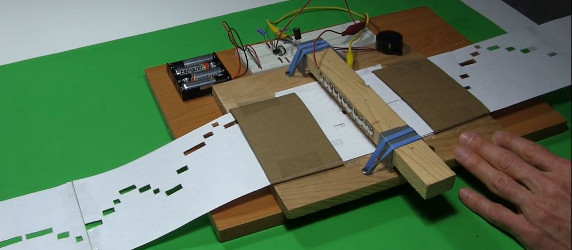
From simple buzzers to an Atari Punk Console, the simple 555 timer chip is the foundation of a whole lot of interesting lo-fi synth projects perfect for beginners. [Steven] put together a great tutorial for using the 555 timer in a rudimentary synth, and even went so far as to build a simple electronic player piano able to play a song from a sheet of paper with punched holes.
The basic 555 oscillator circuit is very simple – just a few caps and resistors and powered by a few batteries. [Steven] built the simplest 555 circuit, but used a line of graphite drawn on a piece of paper for the resistor controlling the frequency. It’s basically a drawdio built on a breadboard, and easy enough to build for even the most neophyte electronic tinkerer.
Going one step further, [Stephen] drew a long thick line of pencil graphite on a piece of paper and mounted eleven wire loops attached to the circuit over his improvised resistor. After cutting a few holes in a piece of paper, he was able to create a simple player piano with his 555 synth. It worked well enough to play Greensleeves, and is the perfect project for the budding electronics hacker.
[youtube=http://www.youtube.com/watch?v=rTmlR8B-u5c&w=580]
[youtube=http://www.youtube.com/watch?v=PSQ6AqqhSgo&w=580]
















Awesome and simple.
So can this be used to read scantron cards?
I always figured scantrons were an optical deal, but the requirement of a #2 pencil having something to do with the conductivity of the filled-in circle doesn’t sound too out-there either. I guess I can do some research on it now with the internet at my fingertips.
I worked for a few years for a school system, I got the joy of fixing the scanner used on the scanton type bubble, #2, tests. They reason for the pencils is for an optical scanner to read them but its not visible light, the scanner I worked on used IR, it could do several dozen sheets per minute, it was just a bar like the music note thing, it could read both sides of a test at once, was hooked to a computer and you had to prepare an answer sheet first. The software would read the key provided first then knew what to expect for the batch until a new key was read. This also is one of the reasons teachers would say “don’t make stray marks” because the students didn’t know where the “key” page marks were and you could if you knew turn your test into the “master key” by which the rest of that batch would be read. (why cheat when you can just turn your test into the expected answers, then all your peers would be judged by your test ) During the run it would also reject pages that didn’t meet its requirements such as a name or other expected information. All in all a very simple machine, the single machine in a few weekends of use would grade tens of thousands of tests for schools across the state.
I think it would have been fun to have it play sound for each bubble ;)
I don’t see why it couldn’t, but you can only make so many tunes out of A, B, C, and D.
Awesome and simple. I can imagine using resistors hanging from the top piece and metal instead of graphite on the bottom being more practical/easily calibrated though. Still very well put together and thought out.
cool little project. can’t help but think that he could use 2 wires side by side per musical note then he could draw his song in pencil instead of having to cut the paper. of course, that would mean an entirely different circuit like a mini organ one.
He talks way too much. JUST LET ME LISTEN TO THE NOISE(aka piano)!
ours is much cooler ;)
http://www.decapbeatmachine.com
you just build some sort of stylophone